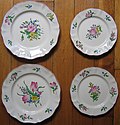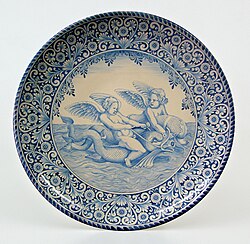Faience

Faience pottery is tin-glazed pottery. It is the use of a white pottery glaze suitable for painted decoration. This is got by adding an oxide of tin to a lead glaze.
It was a major advance in the history of pottery, made about 500 years ago. The technique was brought to Al-Andalus in Spain from Moorish potteries in the eastern Mediterranean.
In Italy locally produced tin-glazed earthenwares was called maiolica. It reached a peak in the late fifteenth and early sixteenth centuries.[1]
It was made in several countries. English creamware was developed in Staffordshire in the 18th century. Instead of faience they were called delftware.
Faience Media
Sophisticated Rococo Niderviller faience, by a French factory that also made porcelain, 1760–65
Hispano-Moresque ware dish from Manises, 15th century, the earliest type of European faience
By the mid-18th century, glazed earthenware made in Liguria was imitating decors of its Dutch and French rivals.
shabti figure in Egyptian faience
Painting a plate before firing in a kiln, Gülşehir, Cappadocia, Turkey
Faience from Laterza, Italy
References
- ↑ Alan Caiger-Smith 1973. Tin-glazed pottery. London: Faber and Faber.








